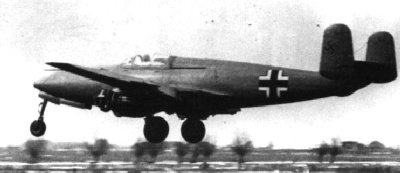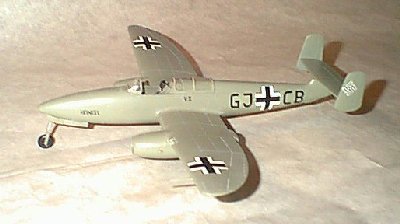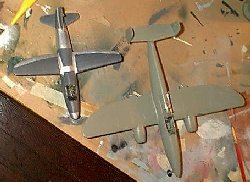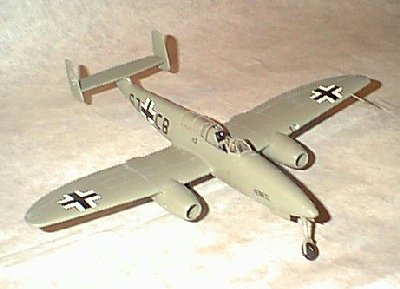





|
|
|
|
|
|
|
|
|
Heinkel HE-280 |
|
|
|
|
|
|
Contrary to what most people may think, the ME-262 was not the world's first jet fighter. Neither was the British Meteor. They did reach production and active service, but Heinkel led the way - though their efforts did not lead to a production contract.
Following the successful test programmes of their HE-172 v1 and v2 prototypes - the first successful jet powered aircraft - Heinkel started working on a jet fighter. The HE-280 was the result. When demonstrated to the Luftwaffe, it outflew and outmaneuvered the best fighter of the time, the FW-190. Unfortunately (or fortunately, from the Allied point of view,) Heinkel was not a manufacturer in favor with the upper leadership of Nazi Germany, so what could have been a devestatingly effective jet fighter coming into service well before the Allies had achieved air superiority was relegated to the role of test aircraft. Meanwhile, Messerschmidt was instructed to begin work on their own jet fighter, the ME-262. A total of 9 prototypes were made, but only 3 were powered.
Had the Heinkel HE-280 gone into service, it would have been a rude shock to the Allied pilots fighting over Europe. It would have been armed with three 20-mm cannon, and would have been powered either by the Jumo 004 or Heinkel's own turbojet design, the HE-S series.. (This design was part of the reason for the delay.) It was also tested with the Argus pulsejet engines, made famous by the V-1 flying bombs.
If you want a kit with a simple paint scheme, this is the one... Four colors are involved (RLM 02 Grey, Black, Aluminum, and Gun Metal - obviously a few more if you detail the instrument panel, but not many!) Eduard makes two versions of this kit - the regular version (reviewed here,) and the "Profi-Pack," which includes parts to make the alternate engined version and (I believe) some more resin detailed bits. Since the HE-280 never went into service, there's no real weathering to be done to it, and the most a detail maven that wants to be accurate could do is remove the left wing's engine pod and show a Jumo engine being flown without a cover. If you choose to do a "what if" (which I'm considering if I can get a second kit,) remember to scratchbuild the three cannon openings, shell 'chutes, and the like for the nose.
Eduard took a hint from Tamiya's HE-219 with this kit. They didn't have to include a metal cockpit floor with this, since there is room in the nose, but they did include a form-fitting metal weight for the nose, which sits on top of the nose gear bay. Nice touch. Eduard also went a step farther by including their "Express Masks" for the kit - their version of EZ-masks, which mask the outline (only) of the larger clear glass areas. You're supposed to apply these, then use a liquid masking solution such as MicroMask to "fill in" the area. It seems to be a good way to deal with curves, even if it does entail an extra step - most modellers that discover masking fluid do this anyway with strips of tape.

ASSEMBLY. The kit goes together relatively well. The cockpit assembly is broken apart into three stages - though there is a problem here. The HE-280 had one of the first ejection seats developed, and this is reproduced rather well. If you follow the directions, however, they have you attach the seat bottom behind a small rise on the cockpit floor. If you do this and let it dry, when you attach the seat back to the rails, it ends up being too high for the canopy to close. Attach the seat back, then the seat pan, and it fits fine. I did not weather the cockpit. The instrument panel is somewhat detailed - dial and switch positions are there, but there's no detail as to which dials are which. I could not find any pictures of the cockpit, however, so I left this as is. The rest of the cockpit went together easily. There are no seat belts included, even as decals, so I added some from painted masking tape. This is a noticable omission.
The next step is assembling the nose gear bay, nose weight, and cockpit assembly into the fuselage halves. The fuselage halves fit together well on a dry run, but when the nose bay was added, a gap appeared. I progressively narrowed the rear bulkhead until it fit - there was still a slight gap, but not much. The nose gear bay has no detail - but again, any detail in this area at this point would have been purely speculation. There are no sidewalls to the nose gear bay. Contest builders and detailers may want to close this in and put in some sort of "generic" nose bay detail.
While this is glued, taped, and set aside to dry, the wings are set up for assembly. Be sure you are paying attention to which slots to open in the lower wing for the engine nacelles - there are four slots per wing, but only two are used in this kit (the other two, I assume, are for the alternate engine assemblies in the ProfiPack kit.) The plastic here is actually rather thick, and it will take some time to thin out and cut through. Widen and lengthen the openings a bit more - widen them towards the inside - or you may run into fit problems further on in assembly. The landing light opening should also be made a touch wider - do not close this in, even though it is an open hole into the wing itself. The landing light piece is solid, and will cover everything. The wings fit together all right, though the trailing edge is  quite thick looking and will probably need to be sanded down. I had a few minor gaps, easily filled. (As a side note, the wings are the strongest resemblance between the HE-178 and the HE-280, as you can see in the accompanying photo of the two kits of them together.)
quite thick looking and will probably need to be sanded down. I had a few minor gaps, easily filled. (As a side note, the wings are the strongest resemblance between the HE-178 and the HE-280, as you can see in the accompanying photo of the two kits of them together.)
After this, all the major assemblies (so far) came together. The mounting post for the twin tail was a bit high, so it was progressively trimmed down (part of the reason I let the fuselage dry first - this post is contained on both halves.) The wings fit together ,a nd I used a combination of superglue and regular glue to attach them, nearly eliminating the gap on the upper surface. Once dry, the lower gap was puttied, sanded, and detail restored.
While these were drying, work began on the engine nacelles. These, not suprisingly, are multipiece affairs. I assembled the intake tunnels, and allowed them to dry. While drying, I worked on the turbine faces and intake/exhaust bullets, finishing them with Rub 'n Buff and assembling them. When everything was ready, they were tacked together with superglue while the liquid cement was applied, and were quickly set into the wings (while the glue was wet, yes, to allow for alignment.) One nacelle came away with gaps, which took some time to fix. I then added the topside fairings for the wing (which also left some gaps,) added the landing light, pitot tube, and canopy.
You may be thinking something's missing - it is. The landing gear had not been assembled yet, and would be added after painting.
Eduard, as mentioned above, includes their "Express Mask" canopy and wheel hub masking system with the kit.I didn't use the wheel masks, but did apply the canopy masks. The canopy was tacked down with white glue prior to painting. The windscreen is provided with two solid covers, and worked well. The larger, clear glass areas are provided with an outline - a single piece for one side, and two for the other (the "front" half of the sliding portion, due to its size.) The interior was then filled with masking fluid. The mask for the landing light is also provided as one piece. The only problem I had with this was aligning the two pieces for the larger canopy mask. The masking fluid (MicroMask) also has a tendancy to stick to the canopy, requiring a lot of work with a fingernail to scrape off. Most other masking systems use solid pieces of material to mask, though I don't know how they handle some of the compound curves such as those that make up the HE-280's canopy. Still, it eliminates the risk of scratching the canopy while cutting your masking material.

The initial coat of RLM-02 Grey was applied, which brought to light some extra seam work on the bottom of the fuselage and engine nacelles that needed attention. These were puttied, sanded, and rescribed, then a new coat of RLM-02 was sprayed. (Testors ModelMaster Acryl II was used throughout.) This was allowed to dry, and the wheels (two piece affairs) were put together. When the paint finished, I unmasked and loosened the canopy (scraping off masking fluid as I want,) and set the canopy back - it's a tight fit, but with a little pressure (not too much,) it actually sits well in the grooves for it. A one piece canopy is also included for those who want a closed version. Jet engine exhausts were metalized with brushed-on Model Master Metallizer - it says "airbrush only," but can be brushed, and came out with no brush marks at all.
The landing gear legs themselves are simply detailed, but go together well. The landing gear bays are all noticably missing any detail whatsoever, being simple "pits" to put the gear legs into. They are small, however, for the main gear, and again, I know of no pictures of this area so I couldn't tell you right offhand how much detail their should be. THe landing gear legs (main) are three piece affairs - the main gear leg, a supporting bit (looks like it assists with retraction) that goes to the front, and another retraction arm to the side. The instructions take a bit of guessing as to if the wheels face inwarrd or out, and if you go by the painting instructions (which I nearly did,) you'll have them with the wheels facing out - which is wrong. Looking carefully at the panel lines shown on the instruction and a picture of the actual aircraft, it becomes apparent that the wheels face inward (which makes more sense looking at the panel lines for the gear doors.)
With that finished, we're on to decalling. The decals, also made in the Czech republic, are printed very nicely and in register - though that becomes a small but easily corrected problem with the swastika marking, split in half to get around some countries laws prohibiting display of the swastika. A dot of black paint in the middle will cure this. The decals came off easily, and respond beautifully to AeroSol II setting solution.
In the end, this kit is not for beginners, but if you've made two or three kits and re looking for something a bit different and slightly more challenging, give this a try. There were no headaches with this kit, save the masking solution, and that's hardly Eduard's fault. Reccommended.
 German Jets : 1944-1945 (Luftwaffe at...
German Jets : 1944-1945 (Luftwaffe at...